Fred Martin
A Retrospective, 1948-2003
Catalog illustrations with commentaries...
Catalog nos.
55-63
Click for
Catalog
nos. 1-26.
Catalog
nos. 30-54
Catalog
nos. 65-77
Catalog
nos. 78-115
Catalog
nos. 119-137
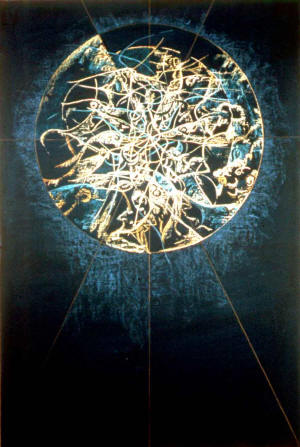 |
Cat. no. 55.
Venus, the Germ of Metal Star. 1974.
Pastel on cardboard, 60 x
40 in.
In Why I Paint and
What My Work Is About, [the
catalog essay for this exhibition] I told about how this painting and the
other planets came about. Well, here is a little more. After I left
administration at SFAI in order to be an artist, I got a job for a
year at Berkeley in order to make a living (Jean was working too, or
we could not have made it). In the UC library I found a book about
Chinese alchemy that said the planet Venus was thought to be the
source of all metals—hence the title Venus, the Germ of Metal Star.
A friend had made my birth chart and Venus and Mars were in
conjunction there. No wonder, I thought, that I am a Gemini.
Furthermore, about the broken necklace—well, life is also like
wandering across the mountains. The mountains are always there, but
you meet them one by one. The planets were mountains always there for
me in eternity, but I found them to paint only in the paths of time.
|
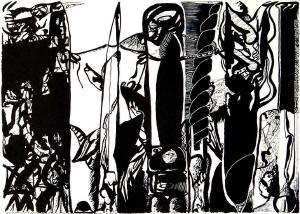 |
Cat. no. 57 Plate
3, Liber Studiorum. 1973.
Offset lithograph on paper, 23 ½ x 35
in.
Collection Oakland Museum of California.
I had a retrospective
at the SFMOMA in 1973. There was to be a catalog, but I wanted more
than the usual book that is only a book, not a work of art in itself.
It was in the air to use the mass media mediums—like offset printing,
for example—to break down the traditional shibboleths about “fine”
art. I decided to make a Liber Studiorum (Turner had made one
of his work, suggested by Claude Lorraine’s of his) that would sum up
my work to that time. The result was a set of twenty 24 x 36 inch
offset lithographic prints. I sold a few hand-colored sets for $400 in
order to pay for the edition, and planned to sell all the rest at the
museum as single black-and-white sheets for a dollar or two each. The
exhibition curator said that would destroy the market structure of
“fine art multiples” and insisted we charge $400 for the black and
whites as a set. We sold none.
|
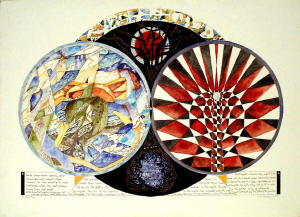 |
Cat. no. 58b. The
Three Trees. April 19, 1975.
Watercolor on paper, 22 x 30 in.
It was the spring of
1975 and my last few months as Vice President for Academic Affairs at
SFAI. I went to an academic conference and had a dream about a
tropical island and a tree beside the ocean. At home, I was reading
about the “preestablished harmonies” of the ancient Greeks and also
about the maypole of medieval Europe as a springtime fertility
symbol. And I was remembering a late antique springtime hymn to
Aphrodite risen from the sea. I used all my geometrical schemes to
make the tropical island on the left, the maypole on the right, and
the cosmic tree in the center. And the hymn? It’s across the bottom…
“He who loved never, let him endeavor; he who loved ever, let him
persever.”
|
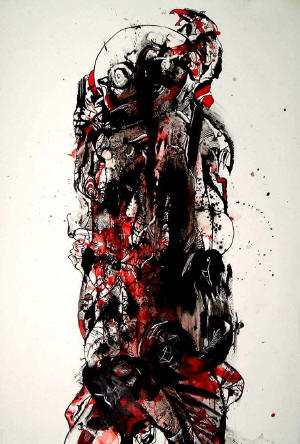
|
Cat. no. 60. Black
Redmon. 1977.
Watercolor on paper, 60 x 40 in.
Collection
Oakland Museum.
There was a time in
1976-7 when the well of my work was dry. A student saw the word
“timeless” in my A Travel Book and said “If you ever want the
timeless, contact the Monroe Institute.” I would do anything to get
the flow going again, contacted the Monroe Institute, and began
several years of work with altered states of consciousness. All the
ways of art making that I had mastered, collapsed. It took perhaps
half a year until I learned how to meet and show beings like this
“Black Redmon” who was all the dark sexual violence deep in my
ancestral medieval soul. I also met and painted “Ikarion,” the
spiritual flyer across all the heavens of eternity. Once I saw the
masters in their gathering place high among the mountains of infinity.
Another time I saw all the souls of all the people who have been or
will be. They were the seeds in eternity.
|
 |
Cat. no. 61. Tree,
August 28, 1978.
Watercolor on paper, 40 x 30 in.
Collection Mr. and
Mrs. Anthony Martin, Atlanta GA.
At the time of
Black Redmon and the other paintings of the places and beings of
my altered states of consciousness (“astral travel”), I read a review
of Nathan Olivera’s large watercolors. The review revived my old
fantasy about “glory” and “majestic size.” If Nate was glorious
because his watercolors were big, I would be glorious if my
watercolors were big—and the beings I was meeting in my astral travels
lived in eternity and were as big as infinity. After a while, though,
I thought that all those big watercolors like Black Redmon were
as logistical a nightmare as my big acrylics had been ten years
before, and I switched to half size. This half-size painting shows a
rainbow tree, its roots dug like claws in the earth in the land of the
horizon of eternity. A sperm cell is on its way to the copulation
that is our timeless act of procreation in this world.
|
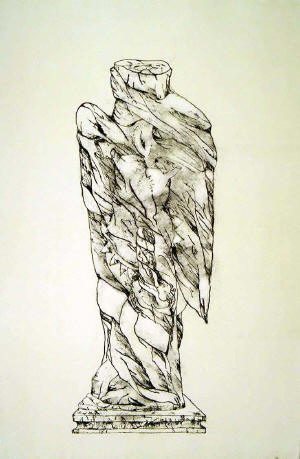
|
Cat. no. 62. Self
Portrait as Herm. 1981.
Drypoint on paper, 60 x 40 in.
Collection Oakland Museum of California.
In
late 1981, Paula Kirkeby invited me to make monotypes at 3EP Press.
One of the conditions was each artist had to make a self-portrait for
gift to the man who donated the very large etching press on which the
monotypes would be printed. I made a series of Scenes from the
Birth of Venus (a takeoff from Botticelli), and then I began a
portrait of my self as a herm. A herm is a column of stone with a
head and an erection in the right place. The Greeks used them to mark
the boundaries of and to fertilize their fields. I broke the head off
my herm, broke off one wing but left another still visible, wrapped my
erection in a ribbon of love, put the sun shining in my solar plexus,
and set all of it reaching for my heart. 3EP found the Scenes from
the Birth of Venus to be okay, but my herm was deemed unfit not
only for publication but also for a gift to the donor of the press.
|
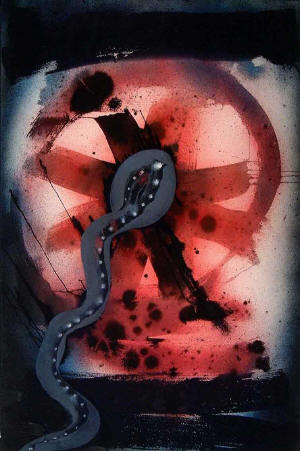
|
Cat. no. 63. A
Snake of Stars in the Setting Sun. August 10, 1981.
Watercolor
on paper, 60 x 40 in.
Collection Oakland Museum of California.
I
stopped making large watercolors like Black Redmon because I
thought there was no point in making such large things. However, I
went back to them because the physical thrill of making them was so
powerful… all the streaming color pouring every way as I held and
turned the painting in my arms and afterward laid it flat with the
painting between but greatly larger than my open thighs. In this way
I would meditate the painting up into me and me down into it as my
mirror, myself. One late afternoon I looked into the west where the
sun was blazing. I put my hand before the sun and saw the light
burning through the red of my flesh. I went into the studio, held and
turned a 4 by 6 foot drawing board stretched with paper and wet with
paint, and made the western sun. Afterward, I sat beside the painting
and took it into me. I saw to paint the snake of stars, my manhood in
eternity.
|
|
|
|
Click for
Catalog
nos. 1-26.
Catalog
nos. 30-54
Catalog
nos. 55-63
Catalog
nos. 65-77
Catalog
nos. 78-115
Catalog
nos. 119-137
|